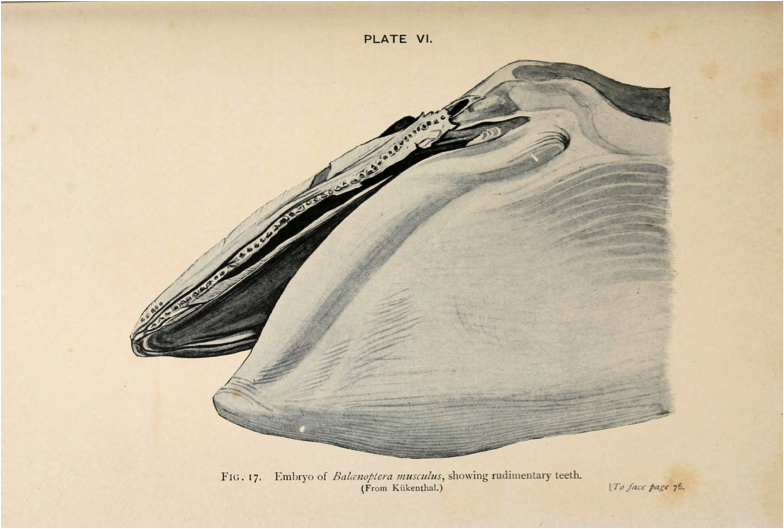Whale of a toxic tale
The blue whale’s testimony to past pesticide use
Rebecca Cudmore • October 2, 2014

An illustrated blue whale embryo. [Image credit: Biodiversity Heritage Libraries via Flickr Creative Commons]
Inside the ear of a blue whale, lies a record of the fluctuating ocean.
Last year, the fatality of a 2007 ship strike provided scientists with a 10-inch column of informative earwax. The victim’s wax was composed of fatty, alternating dark and light layers, each distinctly spaced to depict the highs and lows of food availability during seasonal migrations of a 12-year life. Within these layers, researchers found handfuls of historically used chemicals — of the most concerning, perhaps, were high levels of the long outlawed chemical DDT.
DDT, the global insecticide of choice until the ‘70s, was banned in the U.S. in 1972 for its serious threats to wildlife and human health (it’s still used in malaria-plagued countries). For instance, blood samples of human infants born in the ‘60s reveal that those with mothers exposed to the chemical were much more likely to be born prematurely or with a low weight.
In the dead whale’s ear, this potent pesticide was discovered in greatest concentration in the layers of wax that aligned with infancy — when the whale was less than six months old and still young enough to nurse. The whale’s mother, the study postulates, must have transferred her own ocean absorbed pesticides over to the new baby. This unsettling finding validates prior hypotheses, the study continues, that large marine mammals can pass organic contaminants from mother to baby, through either pregnancy or by nursing.
As the myriad of DDT’s effects remain unknown to science, the whale study cannot confirm how the chemical load influenced the young whale and other animals like it. The authors suggest that the chemical may be related to increased levels of the hormone cortisol, a telltale sign of stress. And, unfortunately, the case of the blue whale is not a lone one. To this day traces of DDT are still found in people and wildlife across the globe — living records of the man-made toxin — stuck in the ears of hundred ton cetaceans, the flesh of farmed salmon, the brains of songbirds, and the milk of a mother feeding her baby.
1 Comment
Things like these finding should be public knowledge using as many as 20 scientist, researchers and ordinary people, hopefully a total team of approximately unrelated people that can describe in what they have found using scientific jargon and researchers postulates and ordinary peoples visual presentation and explanation in as normal as possible laymen language and then they must be given the opportunity to draw their own conclusions as to what they have been shown and they can state their pro’s and con’s about what they have learned. Using the verifiable information provided by the scientist and the information given by they laymen as well well wake people up to the fact that we are destroying ourselves in the pursuit of the dollar. I am not a rabid environmentalist, but I do believe we have and we are altering the elements of the planets life giving resources. Pursuing the dollar at the cost of destruction of living habitat is not a very intelligent move, but those people that get their pockets full of dollars and somehow use the word “progress,” for the good of the human race know they are creating conditions that we can use money to immediately make right, only time will correct the damage we have inflicted upon the planet. There are so many people that are skeptical about changes taking place and those to take place, but the saddest of all is the people that believe the climate change and disruption of natural earthly processes are not taking place and never will. They are in for a rude awakening. Someway, somehow the people on this planet must be made to believe that these things are actually happening. One worried person.
Sincerely,
Justin S. Bays